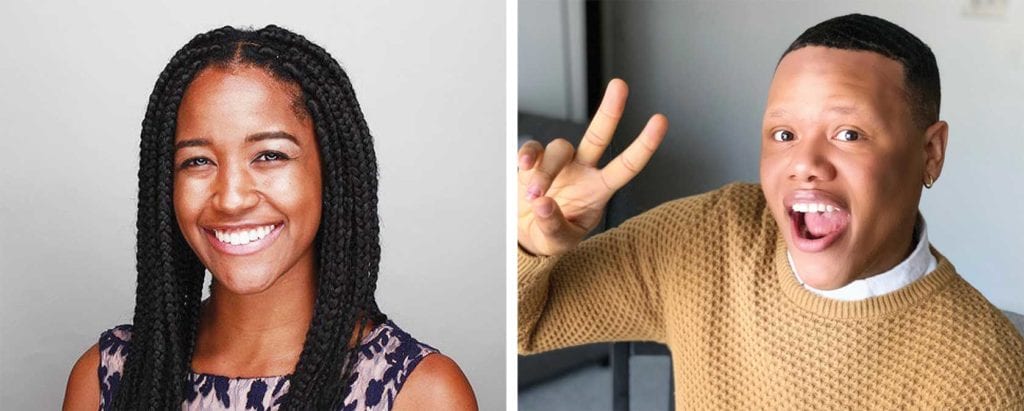
Millions across the country are turning to social media to banish the quarantine blues. But as TikToks gain likes and tweets go viral, other posts flop instead. “Keep It Social,” a new weekly digital series, tackles what’s trending and why.
“Keep it Social” provides a platform for young people to discuss social media. It was launched by WGBH on April 24, and it boasts the tagline “where your timeline is brought to life.” Phillipe Vieira, the show’s producer, told the Banner that “Keep it Social” is catered toward millennials and members of Gen Z: The show is made by and for these generations.
Vieira said that these two demographics are slightly underrepresented in the media, especially when discussing certain issues facing society.
“What you don’t see, especially in mainstream media, is millennials and Gen Z with an opportunity to actually talk about these issues,” he said.
Terrence Johnson, who co-hosts the show with Paris Alston, joined the “Keep it Social” team after graduating with honors from Northeastern University’s College of Arts, Media and Design in 2019. Johnson’s already covered a variety of issues on the show — everything from misinformation about COVID-19 to musical hits on TikTok.
Johnson said the most impactful topic he’s covered, however, concerns students struggling with remote learning during quarantine. Education affects people from all backgrounds, he added.
“Quarantine has been romanticized to some extent, and that just isn’t everyone’s reality,” he said. “It just isn’t everyone’s day-to-day operation. I think using the education piece is a great way to highlight that everyone is experiencing this time period very differently.”
Johnson is interested in a range of topics, including stories about how people are objectified online and how social media sometimes lacks accountability. The goal of the show, he said, is not just to give an update on each platform’s newest features. Instead, Johnson wants to inspire real conversation.
“The goal of ‘Keep it Social’ is not to be necessarily safe,” he said. “We want to push the conversation and we want to invite people to come along on this journey with us.”
Vieira said that feedback from viewers is important, and the team asks people to send in their thoughts about the show.
“We encourage viewers to leave feedback, leave comments, and we’ll take that as just another source for creating the next episode,” he said. It’s a way for the audience to feel like they’re part of the show, he added, as well as part of the editorial decision-making.
The first episode of “Keep it Social” premiered during the height of the pandemic, and the team had to adapt to the new normal. The show was originally meant to be broadcast on WGBH, but social-distancing restrictions prevented studio access. Now, the show is a Zoom-based conversation posted on YouTube and on keepitsocial.org.
“We did have to pivot,” said Vieira. “It is a bit more challenging in many ways.”
Nevertheless, Vieira noted upsides to the adjustments. He said that using a Zoom-based platform reflects the show’s audience, since video conferencing is “very, very popular” among millennials and Gen Zers.
The remote broadcast also gives the team an opportunity to address coronavirus from the perspective of young people, he said.
“A couple of months ago, it was trending, it was hot when millennials and Gen Zers were kind of almost blamed for the spread of the disease in certain places,” he said. “And then everyone you saw on television discussing it were boomers and Gen Xers.”
This gave the team an opportunity to “take control of the narrative,” said Vieira, and provide a platform for young people to express their perspectives and share how the virus is affecting them.
Every segment so far has been “touched by COVID-19,” said Vieira. Studies show that social media is constantly evolving, however, and no one knows what trends will be popular in the future.
“We never know what we’re covering,” said Vieira. “Every week, we start with a blank slate.”
After sifting through social media, each team member selects stories that they’re interested in, he said. Two or three stories end up making it onto the show.
“It’s organic,” he said. “Every week the show is different, every week the show is structured differently, every week the show has different people on it.”
The show looks at certain behaviors and cultures on social media, said Vieira, and the reasons why they’re prevalent.
Vieira expressed various goals for the future of the show: to grow its engagement, remain topical and push conversation, to name a few. He hopes that segments continue to be fun, engaging, interesting and clever. Another key aspect, he added, is “giving a voice to those who typically don’t have a voice on mainstream media.”
“We don’t want this show to turn into cable news,” he said. He emphasized the importance of discourse and conversation rather than people shouting over each other.
Co-host Johnson acknowledged the show’s connection with its audience.
“I am always pushing for the stories that I feel really resonate with people on the other side of the screen,” he said.


![Banner [Virtual] Art Gallery](https://baystatebanner.com/wp-content/uploads/2024/04/Cagen-Luse_Men-at-store-e1713991226112-150x150.jpg)



